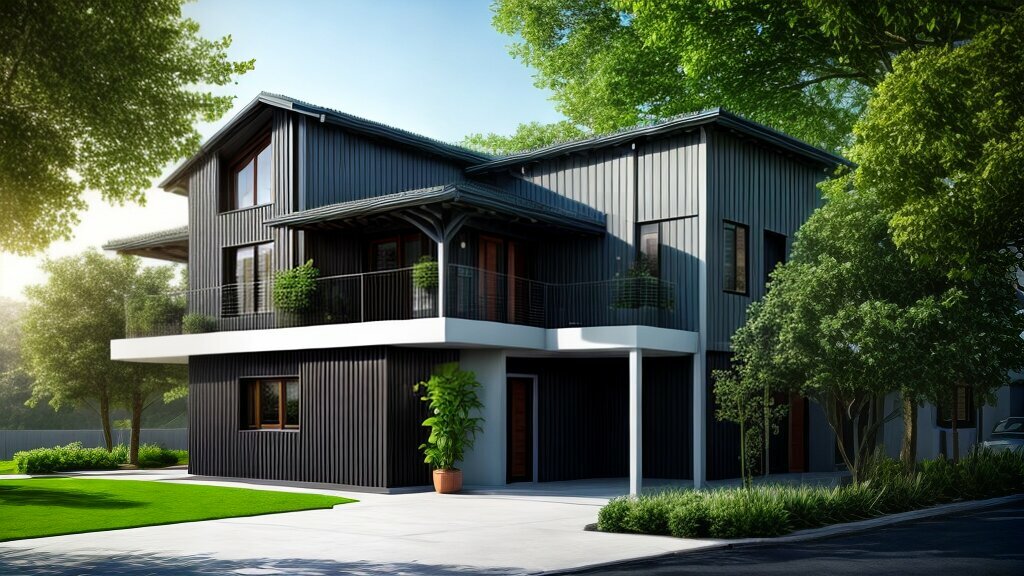Welcome to an exploration of the world of sustainable construction and the role of green building incentives and policies in promoting environmentally friendly practices. With the increasing awareness of the impact of human activities on the environment, it is becoming more important to adopt eco-friendly construction practices. Green building incentives and policies provide a framework for this and contribute to reducing the environmental footprint.
With this in mind, this article will delve into the various incentives and policies that promote eco-friendly building initiatives. We will explore government green building programs, energy-efficient infrastructure, renewable energy incentives, carbon-neutral construction, and more. Additionally, we will present case studies of successful green building initiatives from around the world and discuss future trends in green building.
Key Takeaways
- Green building incentives and policies promote environmentally friendly practices in construction.
- Adopting sustainable construction practices contributes to reducing the environmental footprint.
- In this article, we will explore various green building incentives and policies.
- We will present case studies of successful green building initiatives and discuss future trends in green building.
Understanding Sustainable Construction
Sustainable construction refers to the practice of designing, constructing, and operating buildings in an environmentally friendly and resource-efficient manner. The aim is to reduce the impact of the built environment on natural resources and ecosystems, while creating healthy and comfortable living spaces for occupants.
At the core of sustainable construction are eco-friendly building initiatives that focus on reducing energy consumption, conserving water, using environmentally friendly materials, and promoting biodiversity. These initiatives contribute to sustainable development by aligning with the principles of the circular economy and reducing waste.
Key Principles of Sustainable Construction
The key principles of sustainable construction can be summarised using the three pillars of sustainability: social, economic, and environmental. Social sustainability focuses on creating buildings that provide healthy and comfortable living spaces for occupants, enhance the community, and promote social equity. Economic sustainability focuses on creating buildings that are economically viable, energy-efficient, and cost-effective. Environmental sustainability focuses on creating buildings that have a positive impact on the environment by minimising resource consumption, reducing greenhouse gas emissions, and protecting ecosystems.
Examples of Sustainable Construction Practices
Examples of sustainable construction practices include green roofs, rainwater harvesting, solar panels, and the use of recycled and locally sourced materials. Green roofs provide insulation, reduce stormwater runoff, and promote biodiversity. Rainwater harvesting systems collect and store rainwater for non-potable uses such as irrigation, flushing toilets, and washing clothes. Solar panels harness the power of the sun to produce electricity, reducing reliance on fossil fuels. The use of recycled and locally sourced materials reduces the carbon footprint associated with transportation and production.

Government Green Building Programs
The government plays a crucial role in promoting sustainable construction practices through various programs and initiatives. Green building regulations, in particular, have been effective in shaping construction standards and reducing environmental impact. Compliance with these regulations not only benefits the environment but also provides incentives for the construction industry.
The Leadership in Energy and Environmental Design (LEED) certification is a popular program that encourages builders and developers to adopt eco-friendly practices. The program awards points for various sustainability measures, such as the use of energy-efficient materials, water conservation, and the use of renewable energy sources. The certification is widely recognized and provides a competitive advantage in the industry.
| Benefits of complying with green building regulations: |
| Reduction of carbon emissions |
| Conservation of natural resources |
| Improved indoor air quality |
| Enhanced marketability and brand value |
Government agencies also offer financial incentives, such as tax rebates and grants, for incorporating green building practices. The Federal Energy Management Program (FEMP) provides guidance and support for federal agencies to meet energy efficiency goals. Additionally, the Green Building Adoption Index, a national report released jointly by CBRE and Maastricht University, reveals that the number of energy-efficient buildings has been increasing across the United States.
Incorporating green building practices not only benefits the environment but also enhances the value and marketability of properties. It is important for builders and developers to comply with green building regulations and take advantage of the incentives provided by the government to contribute towards sustainable development.

Energy-Efficient Infrastructure
Energy-efficient infrastructure is a crucial component of sustainable construction practices. With environmental building codes in place, the adoption of energy-saving technologies and materials is now more accessible than ever before. These codes incentivise the use of energy-efficient lighting and heating systems, as well as insulation and ventilation systems that reduce energy consumption.
One of the most significant benefits of energy-efficient infrastructure is its impact on reducing carbon emissions. Buildings are responsible for a significant portion of global greenhouse gas emissions, and the adoption of energy-saving technologies and materials can help to mitigate this impact. Additionally, energy-efficient infrastructure can lead to significant cost savings, making it a practical choice for both homeowners and businesses alike.

Examples of energy-efficient infrastructure include energy-efficient insulation and windows, which help to retain heat during the winter months and reduce the need for heating. Additionally, energy-efficient lighting systems, such as LED lights, reduce energy consumption and greenhouse gas emissions significantly. Overall, energy-efficient infrastructure plays an essential role in promoting sustainability in construction practices.
Renewable Energy Incentives
One of the most effective ways to promote sustainable development policies is by incentivising the use of renewable energy sources in buildings. Governments and other organisations worldwide are providing various incentives for individuals and businesses to adopt renewable energy technologies.
There are several ways to incorporate renewable energy into buildings, including solar panels, wind turbines, and geothermal systems. By using these sources, buildings can reduce their reliance on fossil fuels and significantly decrease their carbon footprint.
One example of a renewable energy incentive is the UK’s Feed-in Tariff scheme, which pays individuals and businesses for generating their electricity from renewable sources. By providing financial rewards, this scheme encourages the adoption of renewable energy technologies and supports the transition towards a more sustainable future.
| Benefits of Renewable Energy Incentives |
Examples of Renewable Energy Incentives |
- Significantly reduces carbon footprint
- Promotes sustainable development policies
- Decreases reliance on fossil fuels
|
- The UK’s Feed-In Tariff Scheme
- US Federal Tax Credit for Solar Energy
- Australian Government’s Renewable Energy Target
|
Renewable energy incentives are designed to support the development and adoption of new technologies, and they are crucial in promoting environmentally friendly practices. By incorporating renewable energy sources in buildings, we can move towards a more sustainable future and reduce our impact on the planet.

Incorporating renewable energy sources in buildings can significantly reduce the carbon footprint. Image source: seowriting.ai
Carbon-Neutral Construction
Carbon-neutral construction is the practice of designing and constructing buildings that produce zero net carbon emissions. This is achieved through the use of sustainable materials, low-carbon technologies, and renewable energy sources to offset any remaining emissions. The goal of carbon-neutral construction is to mitigate the effects of climate change by reducing greenhouse gas emissions.
There are several strategies and technologies used in achieving carbon neutrality in buildings. These include:
- Passive design principles that minimise energy consumption through natural ventilation, daylighting and insulation
- The use of low-carbon concrete and other sustainable building materials
- Integrated energy systems that incorporate renewable energy sources such as solar or wind power
- The use of smart building systems that optimise energy efficiency and reduce waste
Carbon-neutral construction has many benefits, including:
- Reducing greenhouse gas emissions and mitigating climate change
- Lowering energy bills and operational costs
- Improving indoor air quality and occupant health
- Attracting eco-conscious tenants and buyers

Carbon-neutral construction is a promising trend in sustainable development that holds great potential for reducing our environmental footprint. By adopting these practices, we can create healthier, more efficient and sustainable buildings that benefit both people and the planet.
Case Studies: Successful Green Building Initiatives
From LEED-certified skyscrapers to eco-villages, green building initiatives have been a growing trend worldwide. Let’s take a look at some successful projects:
| Building Name |
Location |
Description |
| One Angel Square |
Manchester, UK |
This 14-story office building features triple-glazed windows, heat recovery systems, and an on-site energy center powered by rapeseed oil. It uses 75% less energy than the previous building on the site, making it one of the most sustainable office buildings in the world. (Image source: seowriting.ai) |
| The Edge |
Amsterdam, Netherlands |
This futuristic building not only generates enough energy to power itself, but it also provides surplus energy back to the grid. It uses smart lighting systems, solar panels, and a rainwater collection system to reduce its environmental impact. It has been dubbed the smartest building in the world. |
These projects are just a few examples of how green building initiatives are making a difference in reducing the environmental impact of construction. By embracing sustainability and eco-friendly practices, we can create buildings that not only benefit the environment but also provide a healthier and more comfortable space for their occupants.
Future Trends in Green Building
As society becomes increasingly aware of the need for sustainable development, the green building industry is poised for growth and innovation. Emerging trends and technologies are shaping the future of sustainable construction, and green building incentives and policies are evolving to meet new challenges.
One major trend is the rise of smart buildings, which use advanced sensors and systems to optimize energy efficiency and occupant comfort. These buildings can dynamically adjust lighting, heating, and cooling based on occupancy, weather, and other factors, reducing energy waste and costs.
Another trend is the increasing use of renewable energy sources, such as solar and wind power, to power buildings. Advances in energy storage technology are also making it easier to store surplus energy for use during peak demand periods or during power outages.
Green building materials are also evolving, with new products being developed that are more eco-friendly and sustainable. These materials are made from renewable resources, are more energy-efficient to produce, and have a lower environmental footprint.

In addition to these trends, there is a growing focus on resilience in green building design. Resilient buildings are designed to withstand natural disasters, such as earthquakes, hurricanes, and floods, and can continue to function even if the power grid is disrupted. This can help to minimize the environmental impact of disasters and reduce the need for rebuilding.
As green building continues to evolve, it is likely that new technologies and strategies will emerge to help buildings become even more sustainable and energy-efficient. By embracing these trends, builders and developers can help to create a more sustainable future for themselves and for the planet.
Conclusion
Green building incentives and policies play a crucial role in promoting sustainable construction practices that reduce the environmental footprint. As we have seen, sustainable construction involves adopting eco-friendly building initiatives, complying with green building regulations, incorporating energy-efficient infrastructure and renewable energy sources, achieving carbon neutrality in buildings, and embracing emerging trends and technologies in green building.
The benefits of Green building incentives and policies are significant, including the reduction of carbon emissions, improvement in energy efficiency, and a positive impact on the environment. It is, therefore, essential for individuals and organizations to embrace sustainable construction and contribute to a greener future.
As we move forward, we can expect to see more innovative trends and technologies in green building, as well as increased government and private sector investment in environmental conservation. Embracing sustainable construction practices requires collective effort and commitment from all stakeholders. Let us embrace this journey towards a more sustainable future.
FAQ
Q: What are green building incentives and policies?
A: Green building incentives and policies are initiatives put in place to promote environmentally friendly practices in construction. They aim to encourage the use of sustainable materials, energy-efficient technologies, and renewable energy sources in building projects.
Q: Why is sustainable construction important?
A: Sustainable construction is important because it helps reduce the environmental footprint of the built environment. It promotes the conservation of resources, the use of eco-friendly materials, and the adoption of energy-saving technologies, ultimately contributing to a greener and more sustainable future.
Q: What are government green building programs?
A: Government green building programs are initiatives implemented by governments to promote green building practices. These programs often include regulations and incentives that encourage builders and developers to comply with environmentally friendly construction standards.
Q: What is energy-efficient infrastructure?
A: Energy-efficient infrastructure refers to building systems and materials that are designed to minimize energy consumption and maximize energy savings. This includes the use of energy-saving technologies, such as efficient HVAC systems and smart lighting, as well as the integration of renewable energy sources.
Q: What are renewable energy incentives?
A: Renewable energy incentives are incentives provided by governments or organizations to encourage the use of renewable energy sources in buildings. These incentives can include tax credits, grants, and subsidies that make renewable energy technologies more accessible and economically viable.
Q: What is carbon-neutral construction?
A: Carbon-neutral construction refers to building practices that aim to offset or eliminate carbon emissions associated with the construction and operation of buildings. This is achieved by using energy-efficient technologies, renewable energy sources, and carbon offsetting methods.
Q: Can you provide examples of successful green building initiatives?
A: Yes, there are numerous examples of successful green building initiatives around the world. One such example is the Bullitt Center in Seattle, which is a net-zero energy building that generates more energy than it consumes. Another example is the Beddington Zero Energy Development (BedZED) in London, which is a carbon-neutral community that incorporates sustainable design principles into its buildings and infrastructure.
Q: What are the future trends in green building?
A: The future of green building is focused on incorporating advanced technologies, such as smart building systems and automation, as well as exploring innovative materials and construction methods. Additionally, there is an increasing emphasis on circular economy principles, which promote the reuse and recycling of materials to minimize waste.
Other articles you may like –
4 Perceived Barriers to Sustainable Construction
Episode 13: How Women Can Create Sustainable Change, Especially in Light of the IPCC Report
























Post comments (1)